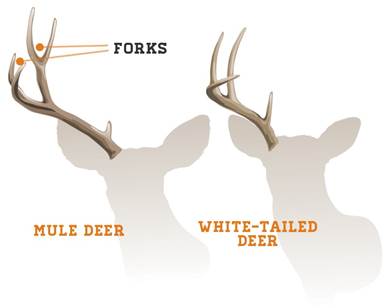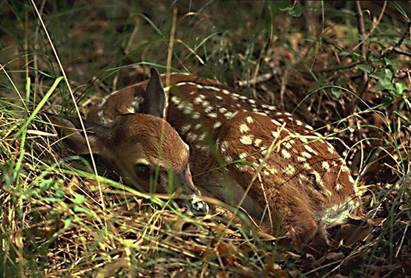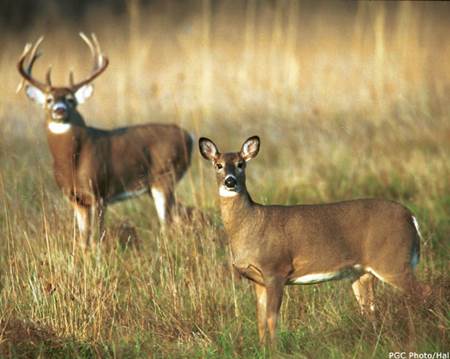He lay with his head against its side. Its ribs lifted and fell with its breathing. It rested its chin on his hand. It had a few short hairs there that prickled him. He had been cudgeling his wits for an excuse to bring the fawn inside at night to sleep with him, and now he had one that could not be disputed. He would smuggle it in and out as long as possible, in the name of peace.”
― Marjorie Kinnan Rawlings, TheYearling
This is an extremely versatile animal that has a range extending from the southern tip of Hudson Bay in Canada well into South America. It is found in 45 of the contiguous 48 states – absent from Utah and rare in Nevada and California, but otherwise present across the U.S. It is found in eastern WA and OR and then down towards the Columbia River in SW WA and NE OR. Because I grew up seeing these as the only native deer in the east, I think of them mostly as an east coast species – but it’s not the case. The limit on their northern extent is due to the combination of severe cold and snow depths that will immobilize them for extended periods.
Odocoileus – Greek odous for tooth and koilo for hollow (???) and virginiana – Virginia, where the typical species was described.
Their numbers have increased across North America as primeval forest has given way to agriculture, suburbs, smaller woodlots, and a more diverse landscape. Pennsylvania in the 1700’s had and estimated population of 10 deer per square mile. Currently the estimate is that there are 30 deer per square mile for a total of 1.5 million deer in the state.
There are a number of subspecies and these deer can range in size from just over 400 lbs. to the diminutive Key Deer of Florida that are only 50 lbs. In Canada and northern US states hunters regularly take deer that are in the 250 lb. range. Deer hunting is big business in many states, significantly contributing to rural economies. And in some states the number of deer killed by automobiles can range from 15 – 100% of the numbers killed by hunters.
In Pennsylvania anywhere from 25,000 to 45,000 deer are killed on roads each year with 124,000 deer-vehicle collisions per year. The average cost of vehicle damage in such an encounter is about $4,000. As I went to graduate school in western Maryland and worked in Pennsylvania for 4 years I’ve had my own share deer meetings – hitting white tails on three different occasions, once having to use the tire jack to push the VW fender out of the way of the tire to get home, and spending too much time banging out dents or in the junk yard pulling off a replacement fender from a dead VW. I was considering renting out my ’78 VW as a deer magnet for hunters.
White-tails eat wide range of food – which helps explain the expansive range, and are considered both browsers (woody material) and grazers (herbaceous material). It is interesting that they will key into the most nutritious vegetation available. In controlled studies, researchers have laid out 10-12 plant browse species with these deer methodically rejecting the ones of lower nutrition value and selecting the ones offering the highest nutrition value. Antler growth depends on two factors – genetics and nutrition, with nutrition being the strongest control. White tailed deer antlers grow with spurs off a single, bent beam, as opposed to those of mule deer, which have a dichotomous branching pattern.

hey also are very tolerant of people and their habits and are often found in suburban areas or in fact denser urban areas. A brother of mine lives in Highland Park, N.J. – a pretty dense town, and often sends me photos of deer lying in his back yard or walking down the street.
White-tailed deer are distinguished by their long bushy tail, tan on top and white underneath, which is erected when the animal is disturbed. The summer coat is a reddish color and in winter it is a thicker blue-gray color. Fawns are a distinctive reddish brown with white spots, which they lose in 3-4 months. This helps the youngsters blend into the ground cover as they will hide while their mother is out and about. Healthy females on good range will bear twins every year during their productive span and 10 – 15% will bear triplets.

Deer heavily communicate through scent and have four prominent set of glands – preorbitals at the corners of the eye; metatarsals on the outside of the leg between the ankle and hoof; tarsals at the hock (heel – but deer are walking on their toenails so the heel is at the leg joint that bends towards the back); and the interdigitals between the toes. The preorbitals help clean the eyes but the others are scent glands that produce a musky oil and are rubbed on trees/rocks to delineate territory. During the rut (breeding season) males will mark our a “scrape” on the ground – pawing up a 9 sq. ft. area and urinating in it and on his tarsal glands to leave his scent and mark out the territory.
Full of vigor and hormones, males travel about in search of females and will scrape trees with their antlers to mark territory or just let off steam. The rut also coincides with hunting season and hunters often rattle found antlers together to attract a buck who thinks others are sparring in the vicinity.
Living in the Allegheny Mountains of western Maryland for graduate school was great for field studies but Frostburg wasn’t much of town – so just to get out and about we would often run the forest trails just outside of town. I was cruising along a narrow path one afternoon that cut across a moderately sloped dense forest when out of nowhere I was knocked to the ground. I got the wind knocked out of me, my face and hair were full of dust, my ear was cut, and I felt a bit woozy.
I stood slowly with my hands on my knees for a bit and there, about 30 yards downslope were a white-tail doe and her fawn – staring at me. Apparently they were trotting down the hill just as I came by and they bowled me over. The doe looked at me and several times stomped one of her front hooves into the ground and snorted at me.
Like what?? That was MY fault??
I jogged/hobbled the two miles back to the road and another two back home, stuffed a plastic bag with ice and put it on the side of my head, cracked a beer, and called it a day.
